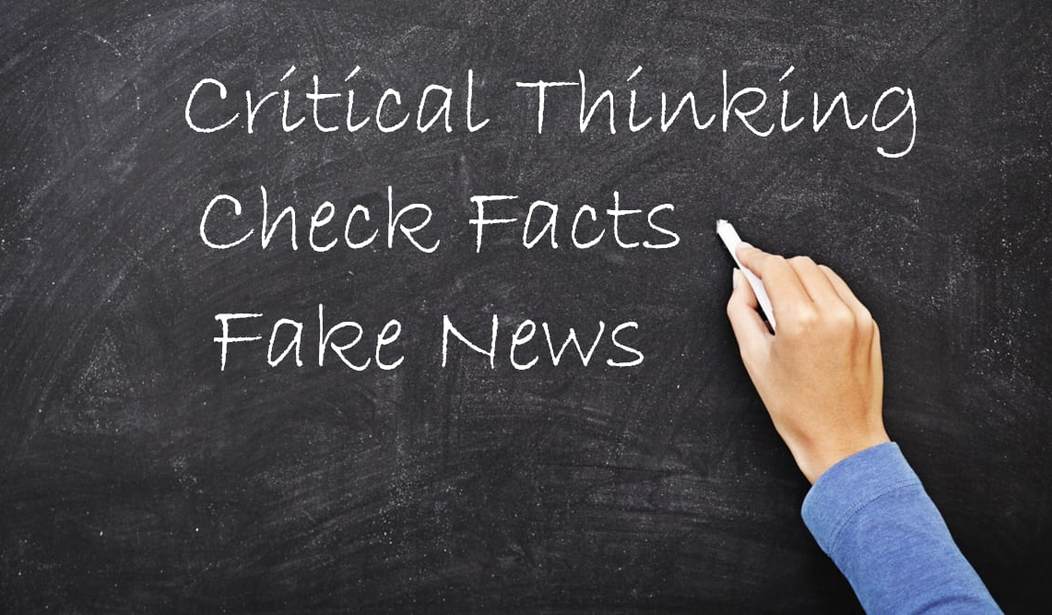In the olden days, people had an expectation of receiving a reasonable level of truth from journalists. Today, journalism’s reputation is so bad that if you asked someone to name three types of lies, they just might say, “Small lies, big lies, and lies by the news media.”
It’s no longer just an issue of identifying misleading headlines, finding a few factual errors, or pointing out an author’s reputation for bias. Modern news is nuanced beyond 50 shades of gray. Today, every story, every sentence, and every word, even if all factually correct, have to be taken in context within the whole and interpreted accordingly. That type of analysis used to be restricted to political statements. Not anymore. Say hello to “fake” news.
The Internet and social media receive much of the blame for fake news and its effect on our civil discourse. But is it really that difficult to recognize fake news from real news? More importantly, is it something that can be taught? Or is really just a matter of consumer partisanship or laziness?
Kristin Schnerer, a Toledo, Ohio, social studies teacher at Start High School, believes it can be taught. She developed a “Media and Politics” course for juniors and seniors with the goal of developing skills in students to help them tell the difference between fact and fiction. The official class goal is:
To enable students to gain the skills needed to critically analyze the news media’s portrayal of important current and historical events, and to better understand the news media’s impact on public policy at federal, state and local levels of government.
Course objectives and other details can be found on the Toledo Board of Education’s website.
Schnerer may be onto something. In a recent study, ACT, formerly known as American College Testing, reports that the majority of college instructors find their entering students critically lack the ability to:
- Determine central ideas
- Identify important details
- Draw conclusions and make inferences
- Evaluate evidence and/or support for an author’s claims
- Distinguish among fact, opinion, and reasoned judgment
The five areas above are really nothing more than steps in the logical thinking process. Therefore, on one hand, Schnerer is basically trying to meet her customers’ requirements: delivering young skulls filled with more brain than mush. A product society has been demanding from public education for years.
However, to be successful, teachers like Schnerer must go beyond simple fact-finding and verification and include contextual integration of the facts. For example, one possible definition of fake news is:
Fake news is a type of hoax or deliberate spread of misinformation, be it via the traditional news media or via social media, with the intent to mislead in order to gain financially or politically.
Not emphasized in the definition is that fake news, when examined in parts, can be 100% correct but still fake.
A recent example of this was President Trump’s actions regarding Obama-appointed U.S. attorneys. In one article, Josh Gerstein used the word “ousts” in the headline in reference to Trump’s actions, even though Gerstein used “replaces” in an earlier article in reference to President Obama doing the same thing. If you examined both articles you might find that both articles are factually correct, but you should also conclude the news was fake, because Gerstein was trying to mislead readers by implying that Trump’s actions were somewhat irregular, illegal, or tyrannical.
The most troubling aspect of social media is the tendency of users to instantaneously believe something to be true simply because it came across their feed. For all consumers of news, especially the young, simply verifying facts beyond their social media feed is still not enough; critical thinking is a must. Some may argue that this is too much to expect from high school students. But is it really that much more difficult than asking them to identify the allegorical meanings hidden in “Moby-Dick”?
Schnerer explained to PJ Media the need to go beyond fact-checking and what her role as a teacher should be:
A significant portion of the class is to help students differentiate between different arguments that media outlets are making …. The amount of information available is daunting, and when students believe the first news article they read without checking for validity, sources, and thoroughly understanding the argument the story is making, they are limiting themselves to one side of the story …. When students finish with this class, I hope they will walk away with a better understanding of the intertwined nature of the media and public policy.
As a teacher, I can give my students the tools to analyze any source as well as teach them how to understand what these sources are actually saying, but it is not my responsibility to push a personal agenda or control the conclusions they come to.
In 1955, Rudolf Flesch published his famous book, “Why Johnny Can’t Read,” irking the education elites and initiating a national debate on teaching methodologies. Ironically, Flesch must have been onto something, because his emphasis on phonics and the use of plain English stirred Dr. Seuss to write his famous children’s books, inspiring future generations of children to never look at eggs and ham the same way again.
Today, many would claim that after over 60 years, Johnny (and Sally) still can’t read. That is, if by “reading” you include those critical thinking skills needed to understand and draw conclusions from what was just read. There are enormous problems with our public education system. Some of those problems involve our false expectations of what public education can accomplish—but that is a topic for another time. For now, maybe someone needs to start another education revolution and write the book, “Why Johnny and Sally Can’t Think.” In the meantime, against all odds, some teachers are trying to get Johnny and Sally to do just that.








Join the conversation as a VIP Member